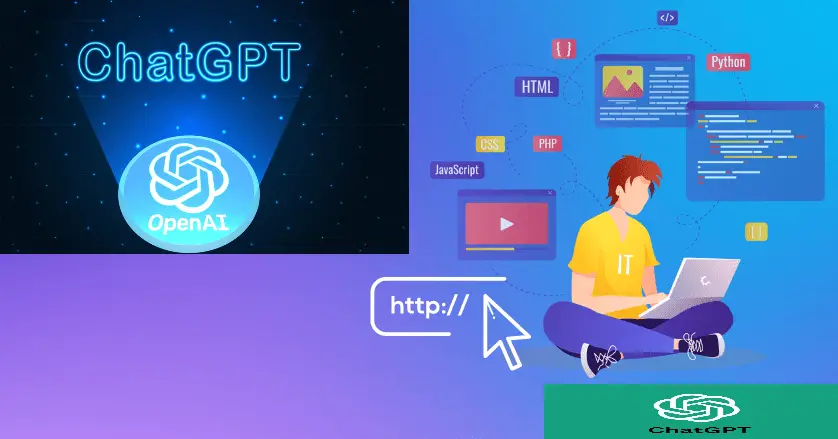It is very important for web developers to pursue innovation if they wish to remain competitive. This is where ChatGPT comes into play as a crucial AI tool.
So, if you are a web developer wanting to know if I can use ChatGPT for Web Development, the answer is a simple yes! Through inputting well-tailored prompts, you can use ChatGPT for web development inspiration, coding and much more.
In this article, I will share how the cutting-edge capabilities of ChatGPT can be used for web development and how developers all over the world can benefit from AI for both Front End and Back End Web Development.
Can You Create A Website With ChatGPT?
Yes, You can create a website using ChatGPT by generating HTML, CSS, and JavaScript code that can form the core of a simple static website.
For example, If you are developing the Front End of the website, you will have to craft Detailed ChatGPT Prompts for Front End Development and describe the type of website you want. With just a few precise prompts, developers can get ChatGPT to produce starter code, database queries, API schemas, and infrastructure configs more effectively.
ChatGPT will then generate a code for the site layout, styling, and interactive elements. You will then need to copy this code into a text editor, make any necessary tweaks, and use a web hosting platform to actually launch the site.
Using ChatGPT For Front End Web Development
Front end development involves creating visually appealing and highly interactive user interfaces using HTML, CSS, and JavaScript. It is crucial for delivering engaging user experiences and seamless website functionality. A well-designed front end facilitates intuitive navigation and access to site content, enhancing overall visitor satisfaction.
Here are some ways ChatGPT can be useful for front end web development tasks:
- Generate HTML markup – Developers can provide outlines of required page sections and content, and get valid HTML generated by ChatGPT. This kickstarts the markup process.
- CSS styling – ChatGPT can suggest CSS rules for layout, responsive design, animations and effects when provided with a description of the desired styling.
- Implement common UI components – For buttons, menus, modals, tabs etc. ChatGPT can provide HTML/CSS/JS code to quickly implement the component.
- Prototype UIs – Developers can describe a new UI idea and get HTML/CSS code from ChatGPT to build an initial rough prototype for testing.
- Suggest layout improvements – When provided existing page code, ChatGPT can propose changes to improve responsiveness, accessibility, performance etc.
- Find and fix CSS issues – ChatGPT can inspect CSS code and detect potential issues like specificity problems, redundant rules etc. and suggest fixes.
- Convert designs to code – Given a design mockup image, ChatGPT can analyze and extract styles to generate starting HTML/CSS code.
- Explain front end code – ChatGPT can provide summaries of what a front end code snippet aims to achieve, helping understand code.
- Choose frameworks and tools – ChatGPT can recommend ideal frameworks like React, Vue, and libraries like Bootstrap for given front end goals.
Using ChatGPT For Back End End Web Development
Back end development refers to server-side coding that powers website and application functionality, database integration, and business logic. It is vital for managing data, connecting the front end to databases, implementing site logic, and ensuring security.
The first thing that you need is to create effective ChatGPT Prompts for Back End Development. With the right prompts, developers can get ChatGPT to automatically generate boilerplate code for common frameworks, produce database queries instead of looking up syntax, quickly mock up API endpoints.
Here are some key ways ChatGPT can assist with back end web development:
- Generate boilerplate code – ChatGPT can quickly provide starter code for setting up APIs, databases, server infrastructure when given a description of the goals.
- Suggest backend frameworks – For use cases like building an API, real-time app or e-commerce site, ChatGPT can recommend ideal back end frameworks like Node.js, Django, Laravel etc.
- Implement simple APIs – Given API specifications, ChatGPT can provide code for basic REST API endpoints and associated logic in languages like Python, JavaScript, PHP etc.
- Write database queries – ChatGPT can generate SQL queries, ORM code, schema definitions for tasks like retrieving, updating data as per instructions.
- Develop reusable functions – Developers can outline common functionality needs and get function code from ChatGPT to reuse across the backend.
- Debug issues – When presented with error messages or unexpected output, ChatGPT can suggest potential causes and fixes in the backend code.
- Improve performance – ChatGPT can analyze backend code and propose optimizations like caching, using faster data structures etc. to improve speed.
- Generate security practices – ChatGPT can provide examples of implementing authentication, access control, data encryption etc. on the backend when prompted.
- Document code – It can create summaries and descriptions of sections of back end code to help with maintaining documentation.
Keep in mind that providing the right Backend Development Prompts to ChatGPT will completely enhance the generated response. By framing requests properly, developers can get ChatGPT to automatically generate boilerplate code for common frameworks, produce database queries instead of looking up syntax, and quickly mock up API endpoints.
Conclusion
ChatGPT has diverse applications in web development and can assist developers with both front end and back end tasks. While it cannot wholly build a website alone, it can help generate code, explain code logic, debug issues, suggest improvements, and automate repetitive coding. With the right prompts, ChatGPT can be a useful resource for web developers looking to increase productivity and innovation.
